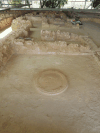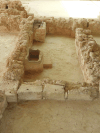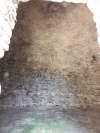
Outer wall of the palace. (1154k)
From the Nestor (mythology) entry in Wikipedia:
Nestor of Gerenia was the legendary wise King of Pylos described in Homer's Odyssey. Excavations from 1939 revealed his palace, and excavations have recently resumed at the site.
Nestor was the son of King Neleus of Pylos and Chloris, daughter of King Amphion of Orchomenus. Otherwise, Nestor's mother was called Polymede.
His wife was either Eurydice or Anaxibia; their children included Peisistratus, Thrasymedes, Pisidice, Polycaste, Perseus, Stratichus, Aretus, Echephron, and Antilochus. In late accounts, Nestor had a daughter Epicaste who became the mother of Homer by Telemachus.
Originally from Gerenia, Nestor was an Argonaut, helped to fight the centaurs, and also participated in the hunt for the Calydonian Boar. He became the King of Pylos after Heracles killed Neleus and all of Nestor's brothers. He was said to have lived three generations by favor of Apollo: the years which the god had taken from Chloris and her brothers, he granted to Nestor.
He and his sons, Antilochus and Thrasymedes, fought on the side of the Achaeans in the Trojan War. Though Nestor was already very old when the war began, he was noted for his bravery and speaking abilities. In the Iliad, he often gives advice to the younger warriors and advises Agamemnon and Achilles to reconcile. He is too old to engage in combat himself, but he leads the Pylian troops, riding his chariot, and one of his horses is killed by an arrow shot by Paris. He also had a solid gold shield. Homer frequently calls him by the epithet "the Gerenian horseman." At the funeral games of Patroclus, Nestor advises Antilochus on how to win the chariot race. Antilochus was later killed in battle by Memnon.
In the Odyssey, Nestor and those who were part of his army had safely returned to Pylos, having chosen to leave Troy immediately after plundering the city rather than staying behind with Agamemnon to appease Athena, who was angered by the heinous actions of some of the Greeks (probably Ajax the Lesser). Odysseus's son Telemachus travels to Pylos to inquire about the fate of his father. Nestor receives his friend's son, Telemachus, kindly and entertains him lavishly but is unable to furnish any information on his father's fate. Also appearing in the Odyssey are Nestor's wife Eurydice and their remaining living sons: Echephron, Stratius, Aretus, Thrasymedes and Peisistratus. Nestor also had two daughters named Pisidice and Polycaste.
Nestor's advice in the Iliad, while always respected by his listeners due to his age and experience, is always tempered with a sub-text of humor at his expense due to his boastfulness, as he is never able to dispense the advice without first spending several paragraphs recounting his own heroic actions in the past when faced with similar circumstances.
In the Odyssey, too, Homer's admiration of Nestor is tempered by some humor at his expense: Telemachus, having returned to Nestor's home from a visit to Helen of Troy and Menelaus (where he has sought further information on his father's fate), urges Peisistratus to let him board his vessel immediately to return home rather than being subjected to a further dose of Nestor's rather overwhelming sense of hospitality. Peisistratus readily agrees, although ruefully stating that his father is bound to be furious when he learns of Telemachus's departure.
Nestor's advice in the Iliad has also been interpreted to have sinister undertones. For example, when Patroclus comes to Nestor for advice in Book 11, Nestor persuades him that it is urgent for him to disguise himself as Achilles. Karl Reinhardt argues that this is contrary to what Patroclus really originally wanted—in fact, he is only there to receive information on behalf of Achilles about the wounded Machaon. Reinhardt notes that an "unimportant errand left behind by an all-important one ... Patroclus' role as messenger is crucial and an ironic purpose permeates the encounter."
Homer offers contradictory portrayals of Nestor as a source of advice. On one hand, Homer describes him as a wise man; Nestor repeatedly offers advice to the Achaeans that has been claimed to be anachronistic in Homer's time—for example, arranging the armies by tribes and clans or effectively using chariots in battle. Yet at the same time Nestor's advice is frequently ineffective. Some examples include Nestor accepting without question the dream Zeus plants in Agamemnon in Book 2 and urging the Achaeans to battle, instructing the Achaeans in Book 4 to use spear techniques that in actuality would be disastrous, and in Book 11 giving advice to Patroclus that ultimately leads to his death. Yet Nestor is never questioned and instead is frequently praised.
Hanna Roisman explains that the characters in the Iliad ignore the discrepancy between the quality of Nestor's advice and its outcomes because, in the world of the Iliad, "outcomes are ultimately in the hands of the ever arbitrary and fickle gods ... heroes are not necessarily viewed as responsible when things go awry." In the Iliad, people are judged not necessarily in the modern view of results, but as people. Therefore, Nestor should be viewed as a good counselor because of the qualities he possesses as described in his introduction in Book 1—as a man of "sweet words," a "clear-voiced orator," and whose voice "flows sweeter than honey." These are elements that make up Nestor, and they parallel the elements that Homer describes as part of a good counselor at Iliad 3.150–152. Therefore, "the definition tells us that Nestor, as a good advisor, possesses the three features ... that it designates." Nestor is a good counselor inherently, and the consequences of his advice have no bearing on that, a view that differs from how good counselors are viewed today.
All pictures are © Dr. Günther Eichhorn, unless otherwise noted.
The Palace of Nestor was an important center in Mycenaean times, and described in Homer's Odyssey and Iliad as Nestor's kingdom of "sandy Pylos".
The palace featured in the story of the Trojan War, as Homer tells us that Telemachus:
The site is the best preserved Mycenaean Greek palace discovered. The palace is the primary structure within a larger Late Helladic era settlement, once probably surrounded by a fortified wall. The palace was a two-story building with store rooms, workshops, baths, light wells, reception rooms and a sewage system.
The settlement had been long occupied with most artifacts discovered dating from 1300 BCE. The palace complex was destroyed by fire around 1200 BCE.
In 1912 and 1926 two tholos tombs north of the Bay of Navarino were excavated. One contained three decorated jars and the other a collection of Early Mycenaean and Middle Helladic pots.
A joint Hellenic-American expedition was formed with the Greek Archaeological Service and the University of Cincinnati and trial excavations of Epano Englianos were started on 4 April 1939. From the first day stone walls, fresco fragments, Mycenaean pottery and inscribed tablets were found. Linear B tablet from the palace at Chora Museum
During excavation in 1939 around 1,000 Linear B clay tablets were found. A systematic excavation was impossible throughout World War II and excavations resumed in 1952. From 1952 to 1966 the Palace was uncovered with areas around the acropolis being further explored. A breakthrough in translating the Linear B tablets was achieved by English architect Michael Ventris in 1952, who found that it was an archaic form of Greek. The translation of such tablets in the following years showed that they consisted of part of the royal archive, thus confirming that the palace served as the administrative, political and financial center of Mycenaean Messenia.
In 2015, the University of Cincinnati uncovered an extraordinarily rich find not far from the palace. This undisturbed burial of a Mycenaean warrior, called the "griffin warrior" by the team, yielded gold rings, bronze weapons, and many other artifacts. The iconography of the artifacts displays a mixture of Minoan and Mycenaean culture.
















This page contains 16 pictures
Here are the links to the other main pages on Greece:
Page last updated on Fri Dec 2 11:51:12 2022 (Mountain Standard Time)
Nestor's Palace at Pylos on soaring.geichhorn.com